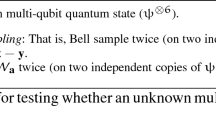Abstract
Two orthogonal arrays based on 3 symbols are said to be isomorphic or combinatorially equivalent if one can be obtained from the other by a sequence of row permutations, column permutations and permutations of symbols in each column. Orthogonal arrays are used as screening designs to identify active main effects, after which the properties of the subdesign for estimating these effects and possibly their interactions become important. Such a subdesign is known as a ``projection design''. In this paper we have identified all the inequivalent projection designs of an OA(27,13,3,2), an OA(18,7,3,2) and an OA(36,13,3,2) into k=3,4 and 5 factors.
It is shown that the generalized wordlength pattern criterion proposed by Ma and Fang [23] can distinguish between most, but not all, inequivalent classes. We propose an extension of the Es2 criterion (which is commonly used for measuring efficiency of 2-level designs) to distinguish further between the non-isomorphic classes and to measure the efficiency of the designs in these classes. Some concepts on generalized resolution are also discussed.
Similar content being viewed by others
Author information
Authors and Affiliations
Rights and permissions
About this article
Cite this article
Evangelaras, H., Koukouvinos, C., Dean, A. et al. Projection properties of certain three level orthogonal arrays. Metrika 62, 241–257 (2005). https://doi.org/10.1007/s00184-005-0409-9
Issue Date:
DOI: https://doi.org/10.1007/s00184-005-0409-9
Keywords
- Average squared correlation
- generalized wordlength pattern
- isomorphism
- main effect plan
- orthogonal arrays
- projection properties



